BigBlue reached out to me to test out their latest solar generator and panel pairing. And there are two reasons why I agreed to create this review:
- My love for LiFePO4 solar generators (because they last the longest – creating long-term value)
- My prior knowledge of BigBlue solar chargers/panels (highly-rated and popular amongst heavy competition)
After testing this kit for myself, below are my findings.
The Cellpowa500 power station and Solarpowa100 solar panel make a great kit that can be easily used for off-grid power. The solar panel is average in terms of power output, but the power station is long-lasting due to its LiFePO4 battery. Overall, this kit is a good value for the price.
I recommend the CP500 and SP100 kit to anyone who just wants simplicity. This kit is easy to use for beginners and doesn’t have complicated features that require additional research to understand.
| Pros | Cons |
|---|---|
| CP500 has 2,000 battery cycles to 80% capacity | Solar panel & power station are rated to handle 24V, 4A (uncommon – you have to use these together) |
| Can recharge CP500 in 3 hrs using the wall charger and 2x USB-C PD inputs | The solar panel is bulky when folded b/c only folds once over |
| CP500 plus the SP100 panel are extremely easy to use | CP500 is heavy for its size (17.2 lbs) |
| SP100 solar panel is specifically designed to be used with the CP500 | Cannot use CP500 AC ports during simultaneous charge/discharge |
BigBlue CellPowa500 Specifications
| Power Station | BigBlue Cellpowa500 (CP500) |
|---|---|
| Battery Capacity | 537.6Wh |
| Battery Cell Type | LiFePO4 |
| Battery Cycle Life | 2,000 Cycles to 80% Capacity |
| Weight | 17.2 Pounds |
| Dimensions | 11.3 x 8.2 x 8.2 in |
| Warranty | 18 Months |
| Input Ports | 1x DC5525 (2.5mm) Solar/Car/Wall Charging Input (110W max) 2x USB-C PD (60W per port) |
| Output Ports | 2x 120V AC (500W continuous, 1,000W peak) 2x USB-A Fast Charge (18W max per port) 2x USB-C PD (60W max per port) 2x DC5521 (Approx. 60W per port) 1x Car Port (120W max) |
| Comes With | CP500, AC charger, car charger, USB-C to USB-C cable, manual, warranty card |
Testing the AC Output Ports
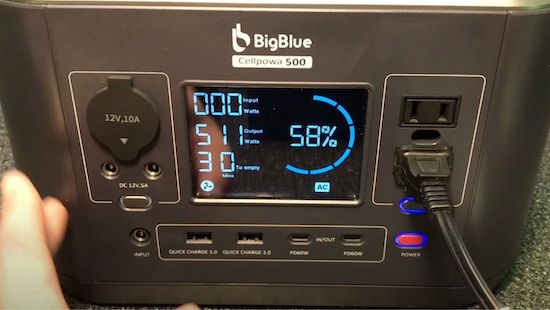
I first tested the AC ports with a small space heater in my office. The heater is rated at 500W, which is the maximum allowable amount of power that I can draw from the CP500.
As I plugged it in, the power increased progressively until it reached about 510W of output.
This is impressive because even after about five minutes of using the space heater, it continued to work effectively at 510W.
I don’t recommend using over 500W from the AC ports, but my test showed that it can handle heavy amounts of power continuously to its specifications.
USB Output Performance
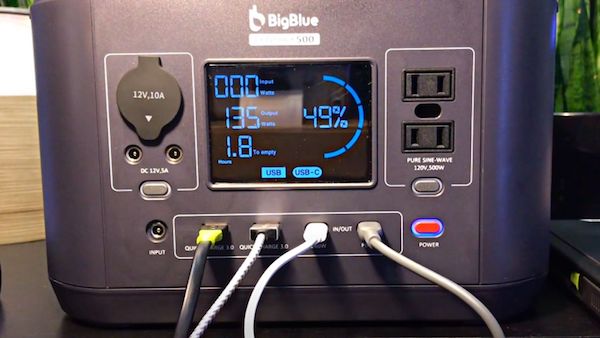
I tested the USB-A ports first and each one put out about 14W of power to my Sherpa power bank. Both USB-As on the Cellpowa500 are fast-charging and can output up to 18W each.
The main reason why I think I couldn’t get the full 18W is that I didn’t have a device that could take in this much power from a standard USB-A connection.
As for USB-C testing, they both worked phenomenally.
The CP500 has two USB-C PD ports capable of 60W of input or output power.
When using the outputs, both of them outputted 62-64W to my Sherpa power bank and Fanttik portable jump starter.
Due to what I believe were cable efficiency losses, each of my devices received about 57-58W of consistent charging power.
DC Ports Testing – 5521 Outputs
On the left side of the system lie the 12V DC outputs. These include two DC5521 ports and one car port.
The DC5521 ports are rated at 12V, 5A (60W) each when used separately. When using both, they split the difference for about 30W from each port.
I tested this port and outputted it to my Jackery 1000 to get a reading of 76W consistently. Clearly, this is over the 60W stated specification for the CP500. This was surprising, as the output adjusted to the device it was plugged into.
DC Ports – Car Port Output
In this test, I used the CP500’s included car charger as an output for its car port. It is rated for 12V/10A (120W max).
Connecting the car charger to the Jackery 1000 again, I received 74-75W of output power.
Combined Output Testing

I tested various port sections at the same time to see whether or not they could all maintain their listed wattage ratings.
My first test was with the DC 12V ports with the USB ports. All USB ports were used as well as a DC5521 port and car port.
In total, the CP500 outputted about 286W from these ports into my devices.
The second output combination I tested was with the car port and AC port. I powered my small space heater to get about 510W, then added the car port output which totaled a consistent 622W of output from the CP500.
Although BigBlue states in the manual that the CP500 should not output over 600W total when combining ports, I wanted to see how it handled at this level.
And after about 35 seconds at 622W, the Cellpowa500 turned off its DC port section while keeping the AC section running.
The space heater continued to run but was held to 500W maximum. At this time, the “DC” icon began to flash on the screen. The CP500 performed the exact procedure (when using over 600W) that was listed in the manual.
This proves that the battery protection systems are working properly to keep the internal components safe.
You can check out my output testing of all ports in my CP500 YouTube review .
.
My Overall Analysis from Output Testing the Cellpowa500
With all of the ports tested, I can say that the Cellpowa500 performed very well and to each port’s specifications.
The one test that stood out from the specs was the DC5521 port. This output gave out more power than was listed in the specs sheet. My best guess is that the CP500 has voltage regulation in this port, allowing it to adjust to the load it is connected to.
in this port, allowing it to adjust to the load it is connected to.
As for noise levels, the CP500 only turns on its fans if it is using in excess of 180W. When I was using my space heater with the power station at over 500W, the noise was manageable and average compared to the other similar power stations I’ve tested, including the:
- Rockpals Rockpower 500 (505Wh battery)
- OUPES 600W (595Wh battery)
- EcoFlow River Max (576Wh battery)
Wall Charging the Cellpowa500 (Input Testing)
The included wall charger brought in about 91W of power into the CP500. At this rate, the system should be able to recharge from 0-100% in about six hours.
A green LED indicator shows up on the wall charging power brick once it is plugged into the wall. When recharging the power station for over an hour, the charging brick was warm, but not hot.
This is standard with most solar generator wall chargers.
The wall charger input on the CP500 is a DC5525 input. This input is also used for the car charger and BigBlue 100W solar panel.
USB-C Charging
BigBlue included two 60W USB-C ports that can be used as charging inputs. This is important because it adds up to 120W of additional charging power to the wall charging method.
I used both USB-C ports to recharge it and received the 120-122W of input. At this rate, the CP500 recharges in about 4.5-5 hours.
Combined Charging (Wall + USB-C)

You can combine the USB-C inputs with the wall charger to get a recharging time between 2.8 and 3.2 hours.
Using this method, it’s important to note that the cooling fans turn on. This is because any input over 180W causes the fans to activate.
When testing this charging method, the total power going into the CP500 was about 214W.
100W BigBlue Solar Panel Charging Test
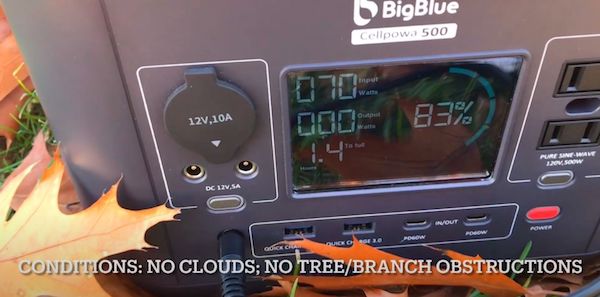
After seven total tests using the BigBlue 100W solar panel, I got the maximum output of 71W. At this rate, it would take 7.5 hours to fully recharge the CP500.
Most of my testing was in adverse weather conditions, which cause the panel to underperform.
You’ll see my details of each test below.
Testing Conditions – Day 1 (Tests 1-7):
- Cold December morning/afternoon in the Midwest United States (25-30 degrees Fahrenheit)
- Sunlight was obstructed by some trees and branches
- Sun was low in the sky throughout testing
- Slightly hazy cloud cover
Testing Conditions – Day 2 (Test 8)
- December in late morning (Approx. 40 degrees Fahrenheit)
- Clear sunlight
- No obstructions from trees or branches
| Testing Number / Time of Day | Solar Panel Output | Conditions Affecting Output |
|---|---|---|
| Test 1 (9:40am) | 28-29W | Solar panel angle wasn’t perpendicular; tree branches blocking sun |
| Test 2 (9:41am) | 32-33W | Adjusted panel angle, but kept in same location |
| Test 3 (9:54am) | 40-41W | Adjusted panel angle again; raked leaves away from front of panel; kept in same location |
| Test 4 (11:41am) | 48-50W | Sun was higher in the sky with less trees & branches blocking sunlight; kept in same location |
| Test 5 (11:48am) | 52-55W | Moved panel to higher elevation w/ less obstructions; raked leaves in front of panel |
| Test 6 (12:08pm) | 59W | Adjusted panel angle; moved panel slightly to avoid tree branch shadows |
| Test 7 (12:12pm) | 63-66W | Moved panel to new location with more sunlight (less obstructions) |
| Test 8 (11:42am) | 70-71W | Clear sunlight with no obstructions; panel angled high |
Due to relatively poor testing conditions, I was only able to capture a maximum of 66W from the sun on day one.
The tree branches in my testing locations were obstructing the solar panel in every test.
There was hazy cloud cover during the majority of my tests.
With these conditions, along with the sun being at a low angle during my entire 2.5-hour testing phase, I am quite surprised that I even got 66W of power from the solar panel.
Day two of testing was completely different – both in output from the solar panel as well as sunlight conditions.
I was able to find a spot where there were no shaded areas, and with not a cloud in the sky, I got a more accurate reading of 70-71W of solar output from the SP100.
Overall, the Solarpowa 100 performed well with the given conditions. Solar panel performance relies greatly on ideal sunlight conditions as well as its angle placement.
In my experience, a good portable solar panel achieves at least about 80% of its rated output in good sunlight.
The Solarpowa100, with 71W out of its 100W rating, achieved 71% of its rated output. I’d put this as average for a typical portable solar panel. However, with my best test being done in 40-degree weather, it’s possible that the SP100 can output more watts in warmer weather.
You can watch my solar testing of the SP100 here on YouTube .
.
BigBlue 100W Solar Panel – How to Use
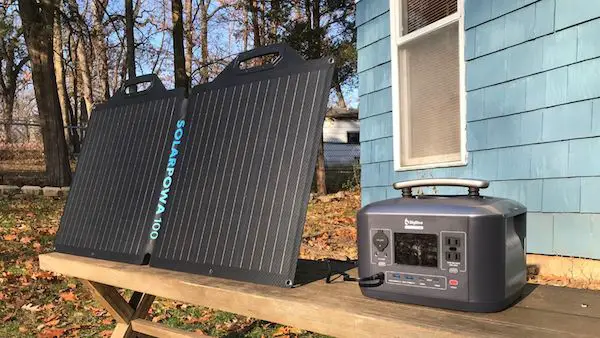
The BigBlue 100W solar panel (also known as the “SP100” or “Solarpowa100”) is used specifically to charge the CP500 power station.
The setup is easy:
- Connect the SAE connector on the solar panel into the extension cable
- Connect the DC5525-end of the extension cable into the CP500
- Mount the panel perpendicular to the sun without any sunlight obstructions
Once these steps are complete, you are ready to charge via solar.
Specs – BigBlue SP100 (100W)
| Model | BigBlue SP100 Solar Panel |
|---|---|
| Rated Power | 100W |
| Working Voltage | 24V |
| Working Current | 4.16A |
| Open Circuit Voltage | 30.2V |
| Short Circuit Current | 4.91A |
| Folded Size | 24.9 x 21.3 x 0.7 in |
| Expanded Size | 24.9 x 42.5 x 0.2 in |
| Weight | 8.2 lbs |
The SP100 also comes with a 6.6-foot SAE to DC5525 connector to pair with the CP500.
There are two legs on each panel, and they have velcro straps to ensure a good angle towards the sun. Each leg also has a button that snaps them into place for storage.
Lastly, the panel is rated at IP65 , which refers to solid object resistance and water-resistance levels. This number is high for a portable solar panel.
, which refers to solid object resistance and water-resistance levels. This number is high for a portable solar panel.
It’s not recommended to use the panel in the rain because the SAE connector is not waterproof, but the panel itself will be able to withstand the elements that come with outdoor use.
Is the BigBlue 100W Solar Panel Worth It?
The BigBlue 100W solar panel is worth it if you intend to use it with the BigBlue CP500 power station. This is because the panel is made specifically for the CP500. Its working voltage (24V) and amperage (4.16A) at maximum power correlate with the CP500’s charging range of 12-30V, 4A (110W max).
If you don’t intend to use this solar panel with the CP500, then I do not recommend it. This is due to its voltage and amperage. A 24V solar panel is uncommon for working with solar-powered generators. These panels are mainly used for large DIY solar generators.
An example of this is for a home backup system, where the 24V panels are attached to the roof and are used to charge batteries through an external charge controller.
If you search for “24V portable solar panels” on Amazon, you will find (at the most) a handful of panels available that are rated at this voltage – and this includes ones that aren’t foldable.
But you will find that a significant number of solar panels are rated at 12-18V because this voltage is the majority-holder when it comes to charging portable power stations.
Similar: ELECAENTA 120W Foldable Solar Panel Review (Testing & Comparison)
Alternatives to the CellPowa500
Both solar generators recommended below are ones that I own and have thoroughly tested.
A more versatile option is the EcoFlow River Max power station. This system recharges very fast due to its 200W solar input max and 300-450W AC charger.
It also outputs 600W continuously from its AC ports in its standard setting. If you use the “X-Boost” function with the River Max you can output up to 1,200W continuously if needed too.
For more information on the River Max, check out my review of it here: EcoFlow River 600 Review – Testing My River Max + Comparisons.
My second option is the OUPES 600W power station. This one uses a LiFePO4 battery like the CP500 and it’s rated for 3,600+ cycles to 80% battery capacity.
Its cycle life makes it one of the longest-lasting power stations you can buy within the 500-600Wh range.
You can learn more about the OUPES system in my review here: OUPES 600W Portable Power Station (Review & Testing).
BigBlue CP500 vs. EcoFlow River Max vs. OUPES 600W
| Model | BigBlue CP500 | EcoFlow River Max | OUPES 600W |
|---|---|---|---|
| Image | 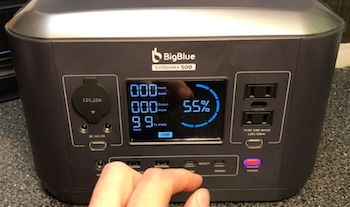 | 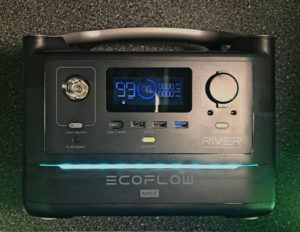 | 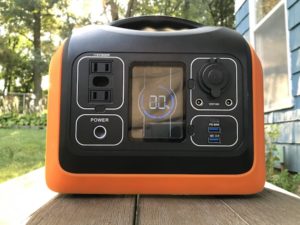 |
| Battery Capacity | 537.6Wh | 576Wh | 595Wh |
| Battery Cell Type | LiFePO4 | Lithium-ion | LiFePO4 |
| Battery Cycle Life | 2,000 Cycles to 80% Capacity | 500 Cycles to 80% Capacity | 3,600+ Cycles to 80% Capacity |
| Weight | 17.2 lbs | 17 lbs | 15 lbs |
| Input Ports | 1x DC5525 (2.5mm) Solar/Car/Wall Charging Input (110W max) 2x USB-C PD (60W per port) | 1x XT60 Solar/Car Charging Input 1x AC Charging Input (400-430W) | 1x USB-C PD Port (60W max) 1x DC Input for Solar/Wall/Car Charging (12-30V, 100W max) |
| Output Ports | 2x 120V AC (500W continuous, 1,000W peak) 2x USB-A Fast Charge (18W max per port) 2x USB-C PD (60W max per port) 2x DC5521 (Approx. 60W per port) 1x Car Port (120W max) | 3x AC (600W continuous, 1,200W surge) 2x USB-A (5V, 2.4A) 1x USB-A Fast Charge (18W max) 1x USB-C (100W max) 1x Car Port (13.6V, 10A) 2x DC5521 Ports (13.6V, 3A) | 2x 110V AC outlets (600W continuous, 1,000W surge) 2x USB-A QC 3.0 ports (18W max) 1x USB-C PD port (60W max) 1x DC car port (12V/10A, 120W max) 2x DC 5521 ports (12V/5A, 60W max) |
| Unique Features | LED light w/ 3 modes Telescoping handle | LED light w/ 3 modes Smartphone app Removable battery | LED light w/ 3 modes Long battery cycle life |
Conclusion
The CP500 paired with an SP100 solar panel is a great solution for you if you’re looking for something that’s:
- Easy to use and maintain
- Long-lasting
- Relatively low-cost
However, if you want more versatility in terms of power (input and output), battery expansion, or solar panel options, there are several other options available that may cater to your off-grid power needs.
For a live look at all of my testing, I recommend checking out my YouTube review below.
You can find the CP500 and SP100 on Amazon below. In addition, BigBlue has a holiday sale from 12/17 to 12/25 with the following savings: CP500 $70 OFF + SP100 $40 OFF (Can save $110):
